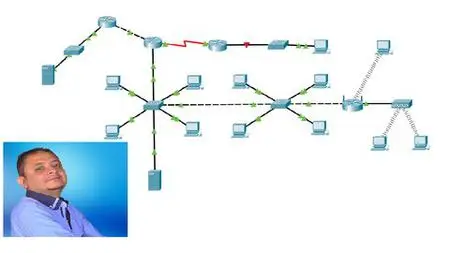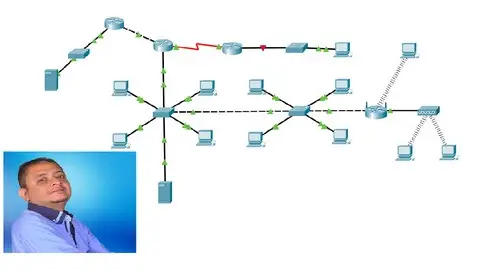Mta - Networking Fundamentals (Teaching And Learning)
Last updated 10/2021
MP4 | Video: h264, 1280x720 | Audio: AAC, 44.1 KHz
Language: English | Size: 2.48 GB | Duration: 7h 1m
Last updated 10/2021
MP4 | Video: h264, 1280x720 | Audio: AAC, 44.1 KHz
Language: English | Size: 2.48 GB | Duration: 7h 1m
Teach and learn Computer Networking the proper way using the Microsoft Networking Fundamentals (Exam 98-366) Curriculum
What you'll learn
Very Similar to my INE Course
Learn how to teach Computer Networking using step-by step theory & project-based lectures (For Instructors)
Teach Computer Networking using logical and systematic methods (For Instructors)
Build and practice with your network as you learn (for students)
Prepare for the MTA - Networking Fundamentals: Exam 98-366 using step-by-step learning methods (for students)
Learn about LANs, Addressing, Media Types, Topologies, Switching & Networking Models
Learn about WANs, Routing, Remote Access, and Security
Learn about Networking Services: DNS and DHCP
Requirements
Basic Computer and IT Skills (For Students)
CompTIA Network+ or CCNA at least is recommended (For Instructors)
Experience in teaching Computer Networking or desire to teach this topic (For Instructors)
Description
***** Very Similar to my INE Course *****When you learn or teach Computer Networking, you might wonder about how topics should be explained. Should theory concepts such as OSI and TCP/IP models be explained first? Then how students will fully understand and comprehend ideas related to these models such as MAC and IP addresses and how they work in networks? Should they try to imagine this in their minds? And if the addressing concepts were explained first, then how can students fully understand these concepts without seeing them in action before moving to other concepts? Here we see that some practice is needed along with the theory explanation of these concepts. And should the students practice with individual mini labs or with full network from the start that would terrify them with its looking? This course progresses through concepts and topics using step-by step theory & project-based logical and systematic methods which is the solution for these issues. Students should learn with a mixture of theory and practice that moves from one topic to another related one while their network or project grows little by little. So as an example for this step-by-step learning method, in the first lectures, you will learn about what is a computer network, and what are local area networks or LANs, since those are the most basic form of a network you will encounter in real world. After that we have to understand network addresses in order to assign them to devices in our network, and thus enable communication between those devices. But before that, we have to understand numbering systems, such as binary and hexadecimal, since network addresses such as IPv4, IPv6, and MAC are implemented using these numbering systems. Now as you have understood the concepts of network addressing, it is time to practice with them, and we will use Cisco packet Tracer for that purpose. Afterwards, you have to understand how to map between different types of addresses using ARP, or the Address Resolution Protocol, and why this mapping is needed. Also ICMP or the Internet Control Message Protocol will be explained to demonstrate how communication in computer networks works. And again will we practice both ARP and ICMP using Packet Tracer in order to understand the concepts, and start establishing our hands on expertise. The same logical order of topics or lectures will continue to the end of the course. We will use the the MTA: Networking fundamentals curriculum to learn about Computer Networking and build our network through this course.MTA or Microsoft Technology Associate is an entry-level certification that provides the fundamentals of a certain technology based on Microsoft products. The MTA: Networking Fundamentals (exam 98-366) is one of these certifications that will provide essential networking knowledge and skills to you. This certification can be your first step in networking and towards other advanced Microsoft certifications such as MCSA and MCSE. It can be considered as the Microsoft version of Network+ or Cisco ICND1/CCENT. This course will help you to prepare for this certification through building a network step by step, going from LAN, addressing, switching, topologies, media types, and networking models to WAN, routing, remote access, security, and network services. With each step, you will learn the theory and practical skills related to it.I hope that you will join me in this course and start your journey of leaning or teaching computer networking. Happy learning and inspirational teaching!
Overview
Section 1: Intoduction
Lecture 1 Course Introduction & Overview
Lecture 2 Introduction to Networking
Section 2: LANs, Addressing, Media Types, Topologies, Switching & Networking Models
Lecture 3 Understanding Local Area Networks (LANs)
Lecture 4 Understanding Numbering Systems
Lecture 5 Understanding Network Addressing
Lecture 6 Introducing Packet Tracer & Working with Addressing
Lecture 7 Understanding ARP & ICMP
Lecture 8 Working with ARP & ICMP
Lecture 9 Wired Network Media
Lecture 10 Network Topologies
Lecture 11 Token Ring a& FDDI
Lecture 12 Understanding Ethernet
Lecture 13 Working with Hubs
Lecture 14 Working with Switches
Lecture 15 Understanding Subnetting & Default Gateways
Lecture 16 Working with Subnetting
Lecture 17 Invalid IP Addresses
Lecture 18 Configuring Default Gateways
Lecture 19 Understanding Proxy ARP
Lecture 20 Configuring Hosts with a Default Gateway
Lecture 21 Disabling Proxy ARP
Lecture 22 Understanding VLANs
Lecture 23 Working with VLANs
Lecture 24 Understanding OSI
Lecture 25 Understanding TCP/IP
Lecture 26 Working with FTP
Lecture 27 Working with TCP & HTTP
Lecture 28 Working with the NETSTAT Command
Lecture 29 Understanding IPv6
Lecture 30 Working with IPv6
Lecture 31 Understanding Wireless Media
Lecture 32 Configuring & Working with Wireless Devices
Section 3: WANs, Routing, Remote Access, and Security
Lecture 33 Understanding WANs
Lecture 34 Understanding Routing
Lecture 35 Configuring Static Routing
Lecture 36 Working with Dynamic Routing - RIP
Lecture 37 Working with Tracert & Pathping Commands
Lecture 38 Security & Remote Access
Lecture 39 Configuring Default Routes & Working with NAT
Section 4: Networking Services: DNS and DHCP
Lecture 40 Understanding DNS
Lecture 41 Configuring & Working with DNS & the NSLOOKUP Command
Lecture 42 Understanding DHCP
Lecture 43 Configuring & Working with DHCP
Lecture 44 Working with GNS3 & Wireshark
Lecture 45 Other TCP/IP Commands
Lecture 46 Networking Technology Advancements - SDN
Section 5: Bonus Lecture: More courses - Lowest Price
Lecture 47 Bonus Lecture: More courses - Lowest Price
IT Instructors who want to teach Computer Networking using step-by step theory & project-based logical and systematic methods,Students who want to learn Computer Networking from scratch the proper way using systematic methods with logical order,Students who want to study the MTA - Networking Fundamentals (Exam 98-366) Curriculum



